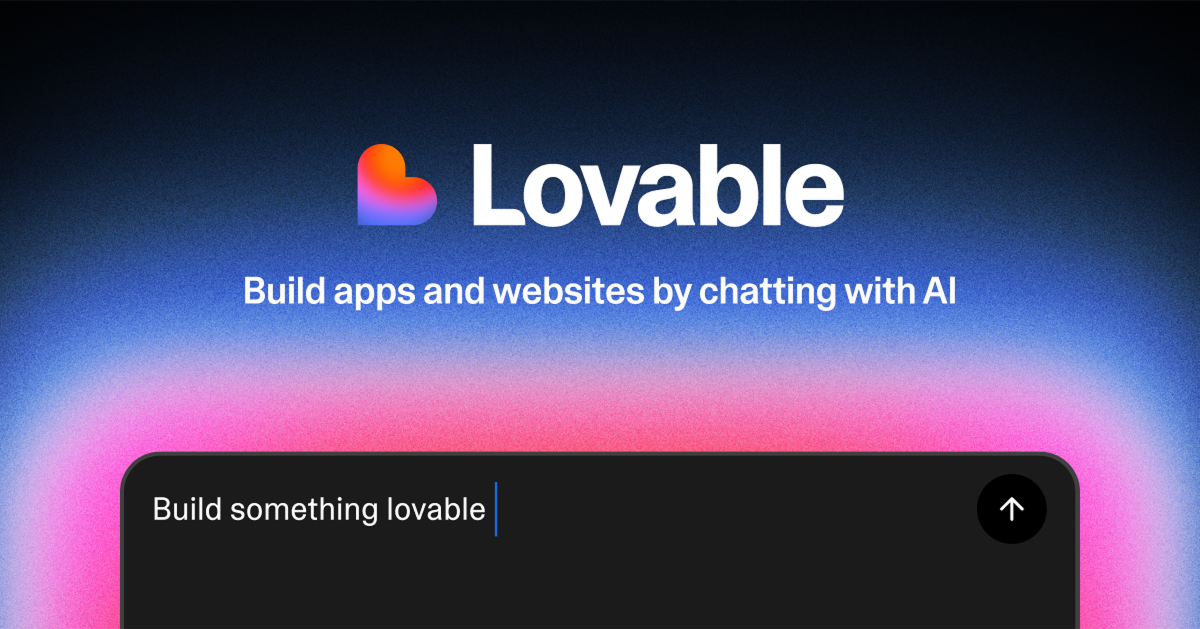How many times have you published a piece of content, and told yourself the piece would drive a lot of traffic to your site?
Then, you publish the piece…and nothing happens.
Sure, you bring some traffic from your own company’s employees. You get a few hundred clicks to your article from your email list. You even get a few dozen views from social media.
Then, you start working on the next piece and let the one you just published sit there, as if it was waiting for Godot.
In my experience, I’ve seen many companies publish a piece of content after the next one without putting much effort into its promotion.
That’s a fatal mistake; if you are going to invest in content, you need to make sure it gets the exposure it deserves.
Where does content comes from?
Whenever I read someone write about content marketing, I see they focus on the first half of the concept: in the content.
There’s no denying that to have a successful content marketing you need to have great content. Who would want to share something that they don’t deem high-quality? Jonah Berger, the author of the book Contagious, explains one of the reasons why people share things is for social currency.
In the book, he said:
Most people would rather look smart than dumb, rich than poor, and cool than geeky. […] What we talk about influences how others see us. It’s social currency. […] to get people talking we need to craft messages that help them achieve these desired impressions.
Although he focuses on things that go viral, the idea holds true for content creators: we need to create content that people can feel proud of sharing. In my experience, some things that have helped me make an article more share-worthy include adding:
- Quotes from experts and influencers
- Stats that prove the points being made
- Unique research and insights
- Simple tools, like calculators
- Action points and recommendations
- Videos, particularly tutorials
- Audio recordings from the article, like the ones Jon Loomer adds to his articles
By adding these elements to your content, you can increase the chances of having your article consumed, shared, and bookmarked. You will be able to make content become one of the foundations of your success.
Most importantly, you will build trust with your readers. You will help people change their lives (or their companies) for the better, and they will want your company to be involved in that change.
You probably agree with everything I’m writing right now. If that’s the case, then what could be wrong with writing high-quality content?
The world doesn’t need another blog post published
Even if you create high-quality content, you need to remember in a world where close to 4 million blog posts published every day.
There are 1.8 million sites in the world, of which 500 million use WordPress.
There’s simply too much content.
If you truly want to reap the benefits of content marketing, you need to remember one thing:
Distribution matters as much as the content you publish.
Getting your content the publicity and attention it deserves takes more than hitting the “Publish” button. As Ryan Holiday explains in his latest book, The Perennial Seller:
Promotion isn’t how things are made great—only how they are heard about.
You need to have a promotion plan in place before you publish anything. This can be as simple as an idea in your head, a 100-words note in your Evernote, or a 10-page strategic plan.
I personally have a checklist that I follow every time I publish a post. It’s very simple in nature, but that’s the point. I have a personal and small blog, why would I want to have a complex plan I won’t follow?
I recommend you have your own.
If you have a content calendar full of articles schedule, I urge you to stop and define your promotional strategy.
Here’s how you can do it.
How to plan your content promotion
Use online communities
One of the rules of promotion is that you need to promote your message where your target audience is.
There’s no better place than in niche-focused online communities, where people are engaged and care about your content—if it’s great.
There are many online communities. The most popular is Reddit. There are subreddits for everything, from eCommerce to one for birds with arms (it’s no joke, check it out). Find your own, and if it’s alive and with a good number of subscribers, do it.
r/entrepreneur is great for business and startup-related articles, and anything close to it.
When using Reddit, be careful because its users can be really mean to people who try to market anything in there. If you want to learn how to promote your content on Reddit, check out this article from Neil Patel and this one from Startup Bros. You should also check out Ross Simmonds’ The Reddit Marketing Code ebook, which is great as well.
If you write about online marketing, like I do, Inbound.org and Growthackers.com are both great. I use them all the time.
There are similar about many other topics.
For example, if you write about food, BakeSpace could be a good place where to share your latest recipes.
Finally, Facebook groups are a goldmine. It’s like Reddit and people can be nicer. Make sure to respect the rules of the group and not be overly promotional.
In the online marketing world, it’s full of groups, like:
Find the ones for your own niche, like travel or real estate, and leverage them.
Online communities are incredibly useful, use them!
Outreach (but only when it matters)
Everyone talks about outreach, but let’s be honest, no one cares about your outreach. Even if you copy Brian Dean’s Skyscraper Technique — which no one seems to understand —, few people will want to open your promotional outreach email.
If you are going to implement email outreach to promote your content, do it when it matters. That includes in some of the following cases:
You are launching new data
If you have carried out original research, then it makes sense to outreach. The reason is simple: it’s original, it’s unique, and it’s useful.
You have put a lot of effort into the article
Both Brian Dean and Neil Patel know that designing a new article matters, that’s how they have been so successful in creating an authoritative blog in the competitive online marketing industry. Look at what Brian Dean has done in this article:

That’s how you can stand out for competitive keywords, as Brian Dean has done so many times. If you show you’ve put effort into your content, it will stand out, and thus people will care.
The article has gotten traction
There’s no rule that says you need to outreach as soon as you publish an article. Actually, I think it’s better if you wait until it gets traction, which can include:
- A few hundred social shares
- Getting in the top positions in an online community
- Mentions from influencers
- Links from authoritative sites
Any of these four aspects give your article social proof and authority, both things to which people love to pay attention.
You have a relationship with the recipient
Every time I read an article about email outreach, I read the same point being mention over and over: relationships.
That is, if you know people who trust you, they will help you promote something.
For example, your employees, your partners, your friends, and other people who owe you similar favors are a group of people who fit this description.
Otherwise, the chances of getting your email ignored are higher, particularly if the article doesn’t fit in the other three categories I just described.
You have mentioned the recipient (in a natural way)
Contextual links carry a lot of SEO power. If you mention me in your article with good anchor and show you truly like my work, I will want to help you back.
The key is to do it naturally. If you force a mention, not only it will not add value to your content, the recipient may be able to see through that and ignore you.
Be realistic about whom you are linking. Some influential people like Brian Clark and Neil Patel won’t care about your mention because they are probably used to getting random requests from people like you.
Make it rain: promote it on social media
“Social media is the hottest thing since the Big Bang” is so ’08. Seriously, no one cares about that BS anymore. All social networks understood they can limit the organic reach of their users, forcing them to pay for more publicity, thus making more money. That means if you post your latest article in your Facebook page, few will see it, even if you have a lot of fans.
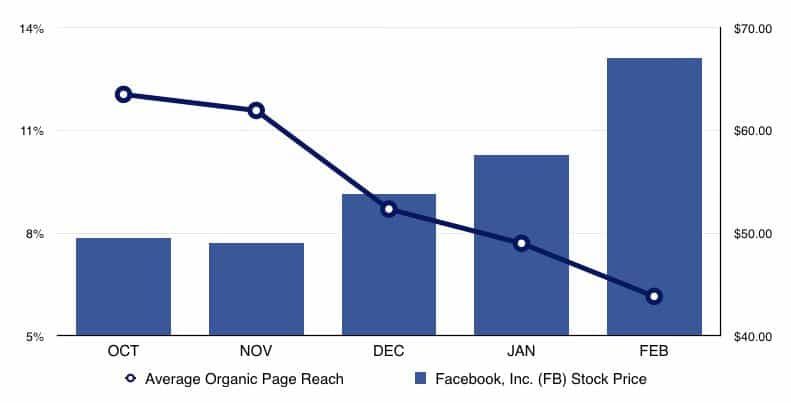
The same happens on Twitter, or in almost any large social network. Organic social media doesn’t exist anymore, so don’t count on it to promote your content.
Since organic reach doesn’t have a lot of power, you need to make it rain, baby! Spend money on your social media accounts, particularly Facebook. With an expected $51 billion in social media advertising spending this year, there’s no going back to organic promotion. Given $40 billion of the total $51 spent worldwide go to Facebook, then you may want to consider it as one of the best places to promote your new content.
You can — and even should — use other social networks, like Instagram, Twitter, Snapchat, and YouTube. But when it comes to promoting written content, Facebook is my favorite place to go.
You don’t have to set up an expensive and complex campaign. Spend $50 or so per campaign using a custom audience based on your email subscribers and website visitors, and to reach all your fans.
Send a great email to your subscribers
One of the most commonly used ways to promote content is through email.
The key of email marketing relies on what Seth Godin calls “permission marketing:” because you get the permission from the subscribers to message your audience, you can get a much higher attention and interest from them.
If you have people on your list, is because they want you to message them. Therefore, use it!
As you have probably guessed, I urge you to be original. If you have an e-commerce store, take a look at the kind of emails that Chubbies sends:
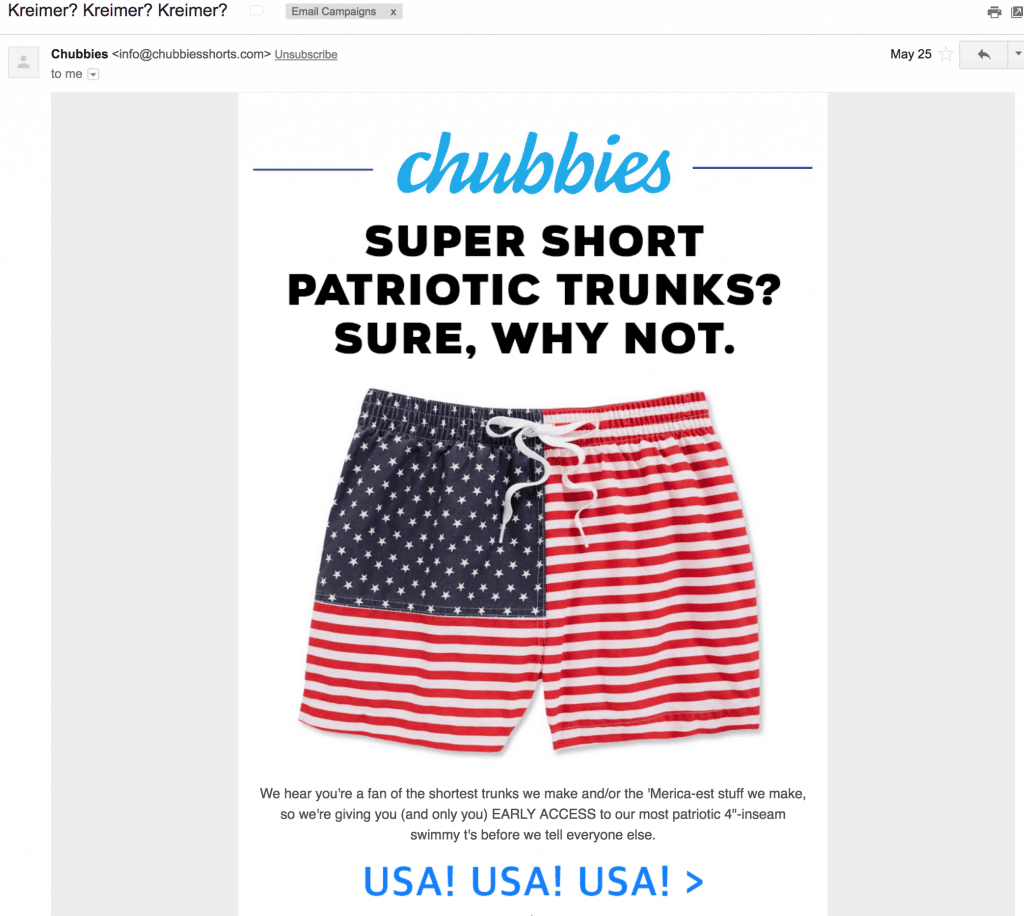
Look at the headline: “Kreimer? Kreimer? Kreimer?” It’s already surprising, weird, and a bit funny. Then, the copy they use and the images are engaging, at least if you are into that kind of humor.
While you don’t have to go as crazy as Chubbies go, trying to go beyond the typical boring email that most retailers send is the best way to engage with your subscribers.
If your company sells SaaS, then you can be more personal and relatable, like the people of And.Co do:

Finally, if your business is content-rich — you know, like if you sell services or digital informational products — then the queen of email marketing is Joanna Wiebe of Copyhackers:
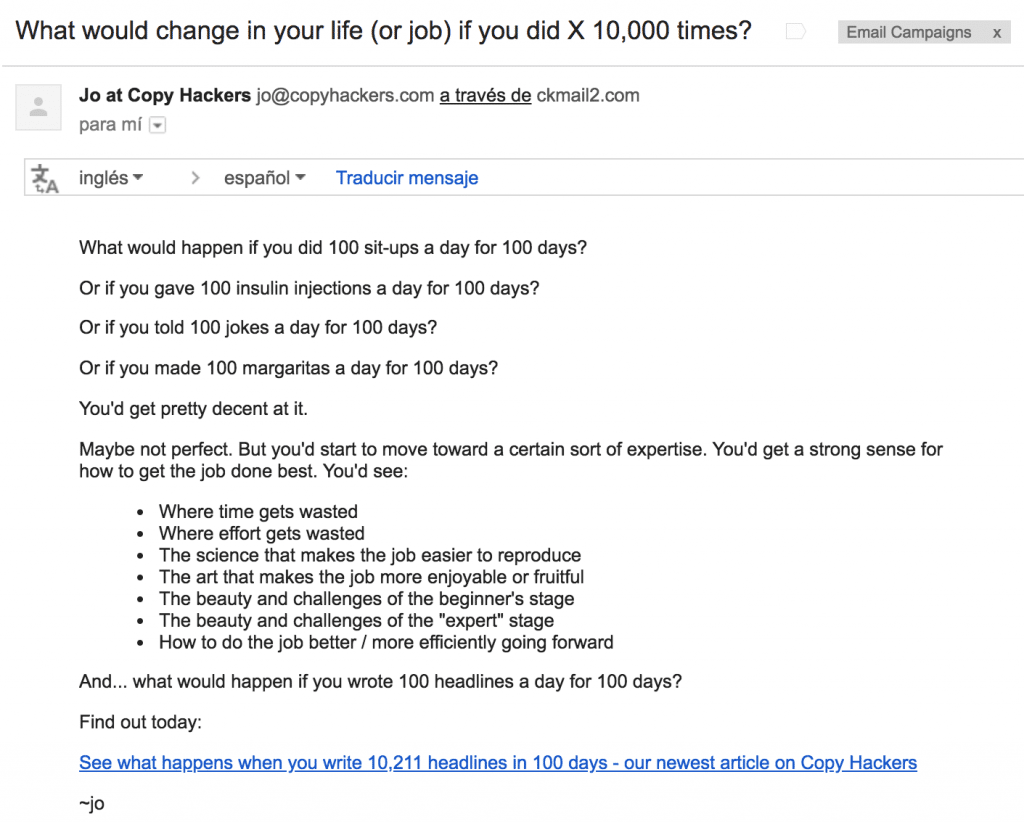
At the end of the day, email marketing is all about connecting with your subscribers, giving value, and asking for little (but when you do, you swing for the fences).
I’ve written extensively about the do’s and dont’s of email marketing on Campaign Monitor, so you if you want to learn more about crafting better emails, check their blog out.
Create guest posts based on the article
Ryan Robinson, a former coach of mine and online buddy, taught me one of the most effective ways to promote content is through guest posts.
Guest posts can take a long time to write, getting accepted, edited, and published. But they are worth the effort.
I personally built my freelance content writing career from guest posts.
Starting with guest posting is quite easy if you have published already in your site for one reason: repurposing.
Take an article you have published, particularly one that has gotten a high share of links, social shares, or comments, and make it different. With the main ideas of that article, change the angle, the order of the ideas, or the length, and republish it.
If you want to learn more, I wrote probably the longest guide on guest blogging there is, so check it out.
Link internally
A simple and often overlooked way to promote your content is to link internally.
I know what you must be thinking: “What? Internal linking is a promotional tactic?“
Well, of course it is!
Linking internally is to content promotion to a father who speaks highly about his kid. Sure, he won’t make his son a star by talking positively about his kid with his buddies, but at least he’ll be able to get him so credit.
At the same time, if you want to give your content a quick boost in its SEO, linking internally with good anchor text and from high-authority pages will help.
Maybe not a lot, but more than enough to help.
All popular bloggers link to their most profitable content (read, the content where they get the most affiliate commissions). Not only helps with the SEO, but it also helps to get more traffic to them from their own site.
For example, Derek Halpern from Social Triggers links site-wide from his sidebar to his most popular posts.
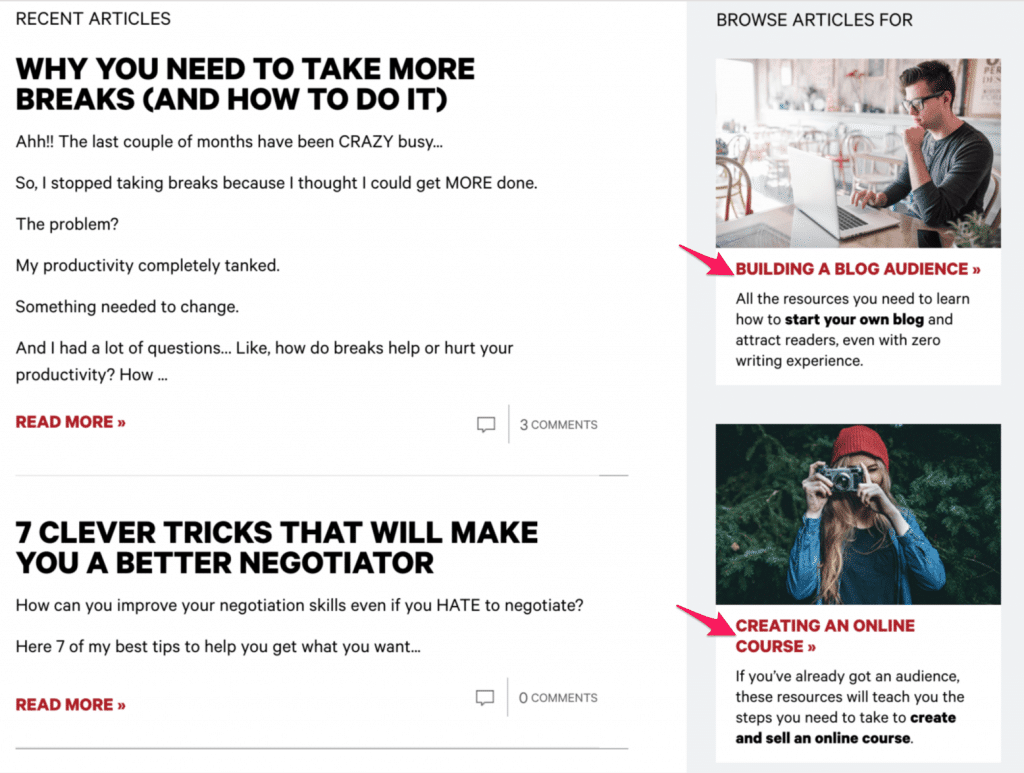
Matthew Woodward does a similar job in his site:
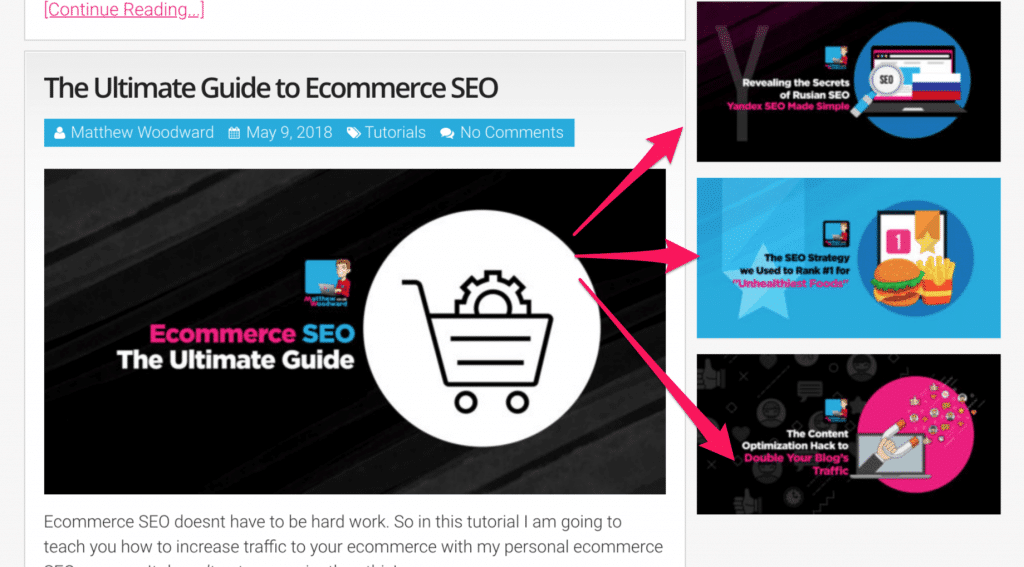
Single Grain, the marketing agency I write for, does the same:

While site-wide linking like the previous examples is the most powerful way to link internally, you can also link on a page-by-page basis, adding a link here and there as you publish new content.
The good part of linking manually is that you can play with the anchor text with much greater precision, which is great for SEO. If you mix that with a guest post, voila! You have a super powerful link to your site.
The bad part is that few people will click that article. If you are going to link manually, do it for the SEO, nothing more.
We don’t have to go far to see a manual internal link in place. If you see above, I said:
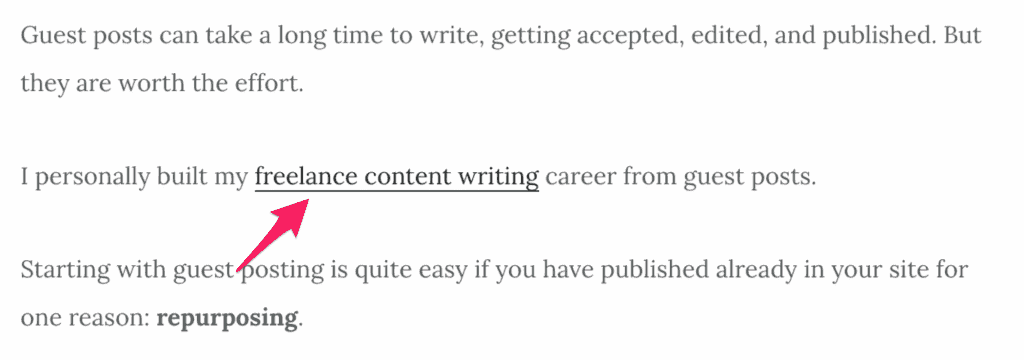
Is that good for that page’s SEO? You betcha.
Will I get any clients? Probably not.
But I don’t care. I’m only building its SEO power.
Talk about it 🤦
This is a huge “duh,” but it’s worth mentioning.
If you truly believe in your article’s quality, talk about it when you talk with your clients, partners, friends, or conferences. Word-of-mouth is powerful, and while it’s not scalable, it can matter a lot.
Conclusion
If you are about to publish a piece of content, I beg you to stop and have a clear idea of what you are going to do with your content.
Remember, content isn’t useful if no one reads it. You need to have a strategy, a plan, or at least, an idea of how it will get distributed.
Don’t blame the writer if the article doesn’t get viral. It’s your job to promote it (and if you ask the writer to do it for you, please make it his job, not his duty).
We don’t need any more content. We need content that people can find.

